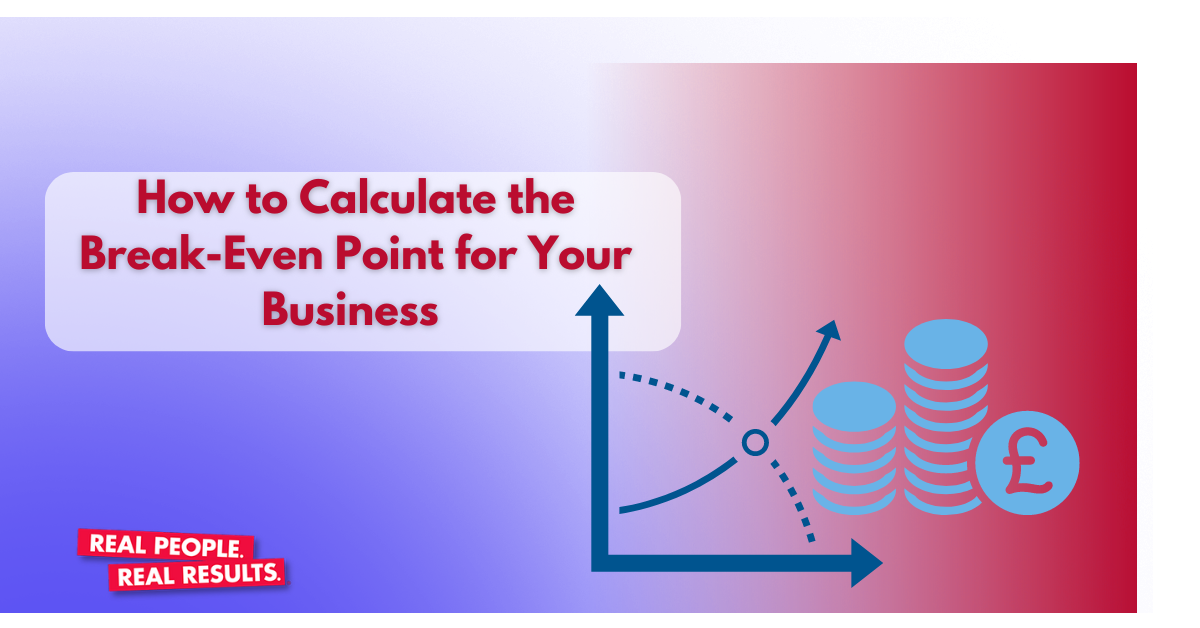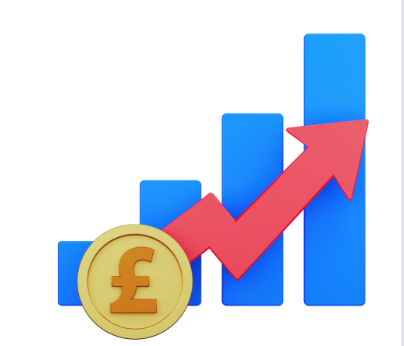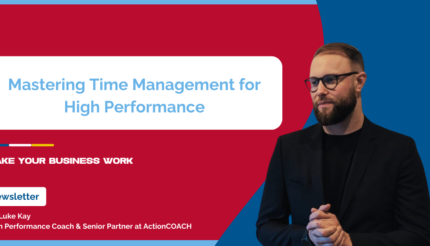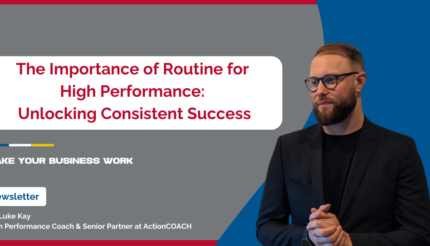
How to Calculate Break-Even Point for Your Business
Firstly, let’s figure out what breakeven means for you and your business.
The biggest mistake I see business owners make is setting their goal to just make payroll at the end of the month.
Their goal is to just get by, and the fact that you are reading this blog might mean that your focus is just getting by.
Think back to why you went into business in the first place, and I can guarantee it wasn’t to “just get by.” So please discard that thinking right away.
Whether you decide to read the rest of this article or not based on the opening paragraph, please take this one piece of wisdom and never forget it:
BUSINESS SHOULD GIVE YOU MORE LIFE, NOT THE OTHER WAY AROUND!
If you are in business to just get by, it’s not worth it—you may as well sell up and get a job. It’s a much less stressful way of “just getting by.”
Now, if the thought of getting a job makes you recoil and you are fed up with just getting by, I’m happy to walk you through how to calculate the first breakeven point for your business. This should cover your personal living expenses and support you in investing in your future so you are not stuck working until you are 80.
So let’s get into it…

Background
One of the best things about being in business is that it is a really unstable asset class.
This is good because you can easily 10X your business in as little as three years if you pull the right levers.
One of the worst things about being in business is that it is a really unstable asset class.
This is also bad because your business can easily fail in as little as three months if you don’t pull the right levers or if something wild happens to the economy out of your control, like war, COVID, Brexit, poor government decisions, etc. But we can only focus on what we can control, so let’s not worry about those too much for now.
The key takeaway here is that we should be using our business to generate excess cash for investments.
In business, we can generate a lot of cash quickly and get really high returns. You then need to invest that cash into more stable asset classes to build long-term wealth for your future. Avoid saying “my business is my pension” because there is a high chance that your business won’t be here in 20-30 years, but more stable asset classes will be.
Yes, we may be able to sell your business for a big lump sum—that should be the cherry on top. This week’s lesson is about setting the right goals to plan for your future, and the stuff I walk you through later in this article will increase the sale value of your company anyway, so it’s a win-win-win all around.
Right, let’s get into setting the breakeven point for your business.
Set a Personal Income Goal
First, set a goal for the income you want to live off to live a relatively comfortable life that makes enduring the roller-coaster life of a business owner worth it. More often than not, you will be eating “s**t” for breakfast most mornings if you are the business owner. There is always some sort of fire for you to put out until you build a good management team.
So whether you need £50K, £100K, or £250K, it doesn’t matter to me. However, whichever you choose, ensure you are taking full advantage of tax breaks wherever you can, as drawing out more than £50K can be expensive, and it gets even more expensive over £100K+. Tax breaks include adding your life partner as a director so you can split the drawings and stay under the various tax brackets if you wish, and making use of electric car schemes, travel allowance, “business trips,” eating out, board meetings, etc.
For easy math, let’s say the income we want for you is £100K per year (including taxes).
We decided that it’s best to add your life partner as a director with the business so we split that £50K each to keep it relatively tax-efficient.

Work on your Investment Income Goal
Next, we need to set a goal for additional profit that we are going to use exclusively for investing in more stable asset classes so you are not working until you are 80.
These could be ISAs, pensions, stocks and shares, property, commodities, crypto, precious metals, etc.
I don’t really care which ones you choose to use, but again, we should be maximising tax breaks as much as possible when investing so we maximise the money you are adding into the investment pot to maximise returns. For example, directors’ pensions save on corp tax and dividends as they are a cost to the company rather than personal drawings.
This might look like maxing out pension contributions for you and your partner, maxing out ISA contributions for you and your partner, setting up a group structure making use of sending dividends up, and making use of inter-company loans to buy a couple of properties per year and investing in the S&P 500 and some crypto. There are a million and one ways to invest.
As a general rule, you want to be getting at least 7% returns on your investments. 10% is great, but be aware that if anyone offers you much higher than that, you might be exposing yourself to more risk—remember, your high-risk, high-return investments are coming from your business.
7-8% annual returns is the magic number because if you multiply something by 1.075 ten times, it doubles. So, you will be doubling your money every 10 years if you get 7.5% returns. The other thing to factor in here is inflation. If inflation is 7.5% each year, then you have just stayed still. While that is better than going backward, and inflation isn’t usually 7%—it’s normally a few percent each year—if we managed to get 10%, it would net us 7%, so we are beating inflation and doubling every 10 years.
Again, it doesn’t matter to me which investment type you go down. Whilst it is a good idea to spread your risk between a few, you run the risk of spreading yourself too thin too early. I would pick something to get going so you can learn all about that one asset class first and then build on from there. A SIPP (Self-Invested Personal Pension) invested in an S&P 500 index fund has been highly glorified over the past few years since Tony Robbins published his book “Money – Master The Game” in 2014. That is what I tend to personally invest in using a Vanguard SIPP, but I have also invested in businesses and property as I know those asset classes pretty well. If you have a property-based business, you may want to focus on that asset class first. Even within the property asset class, you can diversify your portfolio with short-stay Airbnb for higher returns, regular lettings for lower returns, HMOs, commercial property, buying and flipping, etc. So there are lots of options even within one single asset class for you to explore.
I would say, outside of pensions and ISAs, don’t invest in an asset class you don’t fully understand yourself. Or, put in a more positive frame, only invest in asset classes you truly understand. Don’t listen to John down the pub for his advice he saw on Instagram, and also be wary of someone advising you to invest in an asset class they “coincidentally” happen to sell. Do your research and be vigilant.
Also, be aware of investing in property for cash flow—while there are lots of people online telling you how much cash flow their property investments generate, you will probably make more money from property value growing over time than the cash flow it generates. Again, if property prices grow by 7% each year, that’s doubling every 10 years, so factor that into your calculations even if the cash flow yield is not huge.
So, for easy maths, let’s say you wanted to get close to maxing out your personal pension allowance for you and your partner and also invest another £50K in property each year.
So, £50K each in pensions + £50K into property.
So, the total investment income needs to be £150K total (including taxes).

Set a Profit Goal
We have set a goal for your personal income. You want to live off £100K per year.
We have set a goal for the investment income you want to create each year: £150K.
For a profit goal, we need to be able to draw out of the company £250K in total.
(I have put ‘including taxes’ in brackets a few times here just to keep the maths simple – you should speak to a tax expert to get the exact calculations – I recommend speaking to Alexander Myerson if you are based in the North West).
Add the two together, taking into consideration corp tax, cash flow management, and leaving a little bit in the pot each year, we reach a profit target of £350K per year.

Know Your Break-Even Point
So the formula for calculating revenue break even is:
(Fixed Costs+Profit Target) Divided by Gross Profit %.
Now, let’s assume your overheads are £200K per year and you make 50% gross profit.
So overhead is £250K + £350K Profit Target.
= £600K
So now we divide 600K by 50% and we get our breakeven.
£1.2M is your break even in this case.
So if we do £1.2M in revenue:
- £600K goes towards the cost of goods or services.
- We are left with £600K to go towards overhead and profit (£250K and £350K respectively).
Obviously, we would be looking to improve the gross profit by a few percent each year and look to reduce our overheads each year too as we get more efficient. Or our overhead might even increase slightly as we grow, but at least we have got something to work with now.
This £1.2M is your breakeven, because breakeven should always include some sort of profit. If you wanted to go for £2M or £3M or £5M, that’s great, but the breakeven is still £1.2M and nothing less.
Business owners often calculate the breakeven without profit in this case.
£250K/50%
£500K and then say, divide by 12 so £42K is our target each month and then wonder why they are broke, behind with tax, and not making a profit, etc.
Do not fall into this trap.
Business should give you more life, not the other way around. So we need to start building a business that is going to allow us to actually live a life.
Because their goal is just to get by, which isn’t the reason for being in business. Unless you are a charity (which also needs to make a profit) or a not-for-profit, then I’m pretty sure your breakeven should include your profit target too.
Back to the £1.2M: we now need to translate this into sales and marketing KPIs so we know exactly what we need to be doing each month activity wise to hit our target. A goal without a plan is just a pipe dream.
Firstly, take your average order value or average customer spend per year. Yes, you might have different-sized customers; that’s fine. That’s why we are taking an average, and let’s just say an average customer spends £12K with you per year.
We divide the revenue by £12K, and we end up with 100 customers required per year to hit breakeven.
Let’s say our conversion rate is 1 in 5.
We know we need 500 leads per year.
We now have a target of leads to generate each year. We can break that down to monthly targets.
We need 8.3 new customers per month, so let’s call it 9 to exceed it.
So we need 9 x 5 leads per month, which is 45 leads per month.
So for us to hit the £1.2M as things stand, it’s simple maths: we just need to generate 45 leads per month.
That’s how you set a breakeven for your business with an actionable KPI that is clear, means something, and is going to give you profit + investment income.
Bonus Lesson – Getting to £1M in Profit
Now, alongside running this, and the reason why we end up with millions of pounds in profit with our clients, is we look to improve the input numbers we started with.
So even if we only generated 45 leads per month from now on,
If we look to just improve:
- GP%
- Average Client Value
- Conversion Rate
We could drastically shift this business’s profit into another stratosphere. And the good news is it’s not really going to cost us much more. It’s now not as hard as you think to make a ridiculous amount of money because we are out of this “just get by” mindset.
So let’s look at some of the numbers we started with.
How can we improve gross profit?
How can we improve average spend per customer?
How can we improve conversion rate?
So let’s stick with 45 leads per month but improve the rest – we get to work and through working with your coach with clear strategies and focus you end up with the following improvements.
- You Improve Gross Profit from 50% to 55%.
- You Improve Average Annual Customer Spend from £12K average £20K average.
- You Improve Your Conversion Rate from 1 in 5 to 1 in 3.
Now, if we plug those new numbers in, the revenue grows from £1.2M to £3.6M.
COGS or Services would then be = £1.8M
Overheads Still = £250K
That’s close to £1.25M in profit.
Now yes, to grow to £3.6M, we may need to increase our overheads. But even if we increased our overheads by 100% to 500K, that’s still £1M in profit!!!

Key Takeaways
- Never calculate breakeven without profit.
- Once you have calculated breakeven, set marketing and sales KPIs based on those numbers.
- Set targets to improve all the numbers you started at.
This is how you build the business you have always dreamed of and scale from six figures in revenue to seven figures in profit.
That’s what we do here at ActionCOACH.
If you want me to walk you through how this might work for you and your business, then drop me a message or Book a Complimentary Session.
Events
We have a bunch of events coming up over the next few months covering everything to do with Mastering your Business Growth and making your business work without you, so you can focus on the other important things, like life and family etc.
We go deep on topics like finance, marketing, sales, time management, recruitment and we would love to see you there.
To check out when our next event is visit our events page by clicking here.
PS: if you have any questions feel free to reach out to me at lukekay@actioncoach.co.uk – I love helping business owners work through tough challenges and quite often the solution is a quick fix if you know where to look.
Have an awesome day and thank you for taking the time to read this article.





